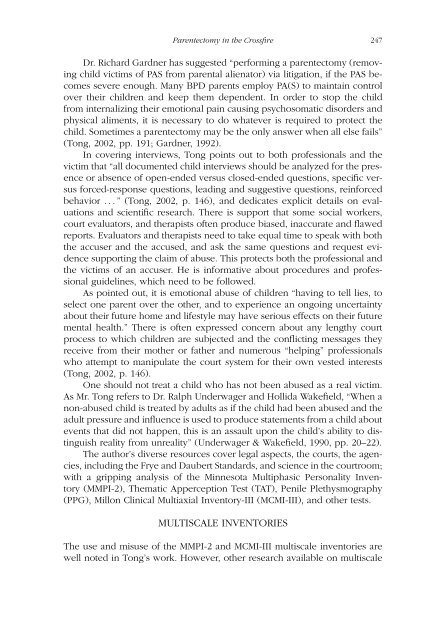Parentectomy in the Crossfire
Parentectomy in the Crossfire
Parentectomy in the Crossfire
Create successful ePaper yourself
Turn your PDF publications into a flip-book with our unique Google optimized e-Paper software.
<strong>Parentectomy</strong> <strong>in</strong> <strong>the</strong> <strong>Crossfire</strong> 247<br />
Dr. Richard Gardner has suggested “perform<strong>in</strong>g a parentectomy (remov<strong>in</strong>g<br />
child victims of PAS from parental alienator) via litigation, if <strong>the</strong> PAS becomes<br />
severe enough. Many BPD parents employ PA(S) to ma<strong>in</strong>ta<strong>in</strong> control<br />
over <strong>the</strong>ir children and keep <strong>the</strong>m dependent. In order to stop <strong>the</strong> child<br />
from <strong>in</strong>ternaliz<strong>in</strong>g <strong>the</strong>ir emotional pa<strong>in</strong> caus<strong>in</strong>g psychosomatic disorders and<br />
physical aliments, it is necessary to do whatever is required to protect <strong>the</strong><br />
child. Sometimes a parentectomy may be <strong>the</strong> only answer when all else fails”<br />
(Tong, 2002, pp. 191; Gardner, 1992).<br />
In cover<strong>in</strong>g <strong>in</strong>terviews, Tong po<strong>in</strong>ts out to both professionals and <strong>the</strong><br />
victim that “all documented child <strong>in</strong>terviews should be analyzed for <strong>the</strong> presence<br />
or absence of open-ended versus closed-ended questions, specific versus<br />
forced-response questions, lead<strong>in</strong>g and suggestive questions, re<strong>in</strong>forced<br />
behavior . . . ” (Tong, 2002, p. 146), and dedicates explicit details on evaluations<br />
and scientific research. There is support that some social workers,<br />
court evaluators, and <strong>the</strong>rapists often produce biased, <strong>in</strong>accurate and flawed<br />
reports. Evaluators and <strong>the</strong>rapists need to take equal time to speak with both<br />
<strong>the</strong> accuser and <strong>the</strong> accused, and ask <strong>the</strong> same questions and request evidence<br />
support<strong>in</strong>g <strong>the</strong> claim of abuse. This protects both <strong>the</strong> professional and<br />
<strong>the</strong> victims of an accuser. He is <strong>in</strong>formative about procedures and professional<br />
guidel<strong>in</strong>es, which need to be followed.<br />
As po<strong>in</strong>ted out, it is emotional abuse of children “hav<strong>in</strong>g to tell lies, to<br />
select one parent over <strong>the</strong> o<strong>the</strong>r, and to experience an ongo<strong>in</strong>g uncerta<strong>in</strong>ty<br />
about <strong>the</strong>ir future home and lifestyle may have serious effects on <strong>the</strong>ir future<br />
mental health.” There is often expressed concern about any lengthy court<br />
process to which children are subjected and <strong>the</strong> conflict<strong>in</strong>g messages <strong>the</strong>y<br />
receive from <strong>the</strong>ir mo<strong>the</strong>r or fa<strong>the</strong>r and numerous “help<strong>in</strong>g” professionals<br />
who attempt to manipulate <strong>the</strong> court system for <strong>the</strong>ir own vested <strong>in</strong>terests<br />
(Tong, 2002, p. 146).<br />
One should not treat a child who has not been abused as a real victim.<br />
As Mr. Tong refers to Dr. Ralph Underwager and Hollida Wakefield, “When a<br />
non-abused child is treated by adults as if <strong>the</strong> child had been abused and <strong>the</strong><br />
adult pressure and <strong>in</strong>fluence is used to produce statements from a child about<br />
events that did not happen, this is an assault upon <strong>the</strong> child’s ability to dist<strong>in</strong>guish<br />
reality from unreality” (Underwager & Wakefield, 1990, pp. 20–22).<br />
The author’s diverse resources cover legal aspects, <strong>the</strong> courts, <strong>the</strong> agencies,<br />
<strong>in</strong>clud<strong>in</strong>g <strong>the</strong> Frye and Daubert Standards, and science <strong>in</strong> <strong>the</strong> courtroom;<br />
with a gripp<strong>in</strong>g analysis of <strong>the</strong> M<strong>in</strong>nesota Multiphasic Personality Inventory<br />
(MMPI-2), Thematic Apperception Test (TAT), Penile Plethysmography<br />
(PPG), Millon Cl<strong>in</strong>ical Multiaxial Inventory-III (MCMI-III), and o<strong>the</strong>r tests.<br />
MULTISCALE INVENTORIES<br />
The use and misuse of <strong>the</strong> MMPI-2 and MCMI-III multiscale <strong>in</strong>ventories are<br />
well noted <strong>in</strong> Tong’s work. However, o<strong>the</strong>r research available on multiscale


